|
The
past few months have been filled with rumors of a new .17
caliber rimfire cartridge and a new Ruger rifle in which
to fire it. Now that the smoke has cleared, and production guns
and ammunition are available, we have been testing the new rifle
and ammo here at Gunblast.com.
The cartridge is a new development of Hornady
Ammunition. Hornady has been the leader among ammo
manufacturers lately in developing new cartridges such as the
.450 Marlin, .480 Ruger, and now the .17 Hornady Magnum Rimfire.
Guns are being produced, or are in development, from Marlin,
H&R, Anschutz, Rogue Rifle Co., Taurus, and Sturm,
Ruger and Company. Ruger chambers both their lever action
model 96/17 and their bolt action model 77/17 for the new
cartridge. The model 77/17 is the subject of this article. We
will look at this new rifle and cartridge on the merits of each
separately, and as the combination of the whole package.
The Rifle
Ruger introduced the rimfire version of their
excellent model 77 rifle in 1983 as the model 77/22. This rifle
is the basis for the model 77/17, the difference being the bore
diameter and chambering. The 77/17 has a big rifle feel to
it, without being overweight or bulky. The 77/17 weighs only six
and one-quarter pounds, and has a twenty-two inch barrel. The
overall feel of the rifle is one of quality. The wood is an
attractive walnut, with a nice satin finish and real hand-cut
checkering. This rifle is built like a big-game center fire
rifle. Most rimfire rifles built today lack the refinements
built into quality center fires. The 77/17, and all of Rugerís
bolt-action rimfire rifles, are built with the same high quality
and craftsmanship as their larger caliber rifles.
The 77/17 has the excellent three-position
safety which allows the gun to be carried with the bolt locked,
but still permits the trigger to be blocked while unloading the
chamber. Another fine feature of this rifle is the patented
rotary magazine, which allows for a nine-shot capacity while not
protruding below the bottom of the action. Many box-magazine
rimfire rifles have a magazine that protrudes below the action,
resulting in a cumbersome carry and looks more like an
afterthought than anything else. The 77/17 action is built
around that rotary magazine, resulting in a superior cartridge
capacity, easy carrying, and improved aesthetics.
The 77/17 has a nice rubber butt pad, not really
needed for the minimal recoil of the cartridge, but a welcome
touch on the classic walnut stock. The trigger guard is made of
genuine, honest-to-goodness blued steel; a feature hardly ever
found on a rimfire rifle these days. Many gun makers, even on
their center fire rifles, have gone to either plastic or
aluminum on their trigger guards. The 77/17 is also supplied
with sling swivel studs. These blued steel parts are a
touch of class on the Ruger rifle, and complement the overall
quality of the product.
One of the best features of the 77/17, and one
that should be found on all rifles, is the included scope rings.
Ruger is one of a very few gun makers that provide scope mounts
and rings with their rifles. The fact that anyone would ship a
rifle that doesnít have open sights without at least a
rudimentary scope mount is ludicrous. The receiver on the 77/17
has built-in mounts to accept the excellent Ruger rings, which
are furnished with the rifle. Other rifle manufacturers should
take a lesson from Ruger, and ship their rifles with a scope
mount.
The 77/17 action has dual extractors which pick
up the cartridge from the magazine and guide it into the chamber
much like a controlled-feed center fire action. The bolt locks
into the receiver with two opposed locking lugs; another nice
touch. The trigger pull on the Ruger is smooth and crisp,
breaking at four pounds. The twenty-two inch barrel tapers to
slightly over one-half inch diameter at the muzzle, which is
finished in a recessed crown.
The Cartridge
The .17 Hornady Magnum Rimfire (HMR)
cartridge was conceived to offer the rimfire shooter a flatter
shooting, farther reaching, and harder hitting cartridge for
small pests and vermin. The basic case for the new .17 is the
same as the .22 Magnum. This offers many advantages in both the
manufacture of ammunition and firearms. The .22 Magnum case is
readily available, and was a natural choice for necking down to
.17 caliber. From the rifle makerís viewpoint, all that is
needed is a different barrel, and their .22 Magnum becomes their
.17 Hornady Magnum.
Hornady advertises their .17 with a muzzle
velocity of 2550 feet-per-second (fps). Over the screens
of my PACT chronograph, the .17 ammo clocked 2448 fps at a
distance of 12 feet from the muzzle, so the ballistics
information from Hornady is very accurate. While the .17 HMR was
not invented to compete with the .22 Rimfire Magnum, comparisons
are inevitable. 2550 fps places the .17 HMR about 700 fps faster
than the .22 Magnum with a forty grain bullet. The shape of the
17 grain .17 caliber bullet also has a much sharper profile than
any of the .22 rimfire bullets on the market. The .17 HMR is
loaded with Hornadyís polymer-tipped .172 inch diameter
spitzer shaped projectile, which is ballistically superior to
any other rimfire bullet.
The initial starting speed and superior
ballistic coefficient result in a shorter time-of-flight
advantage for the .17, decreasing the effects of a crosswind and
flattening the arc of trajectory. Comparing the .17 HMR with the
40 grain .22 Magnum, both sighted to point-of-aim at 100 yards,
the .17 drops less than eight inches at 200 yards, while the .22
Magnum drops almost 21 inches at the same range. Wind drift of
the .17 HMR is roughly half that of the .22 Magnum at any given
range. Any way you cut it, the .17 HMR is the flattest shooting
and fastest rimfire cartridge available.
The Combination
For the shooting of the Ruger 77/17, I mounted a
Tasco 6 to 24 power Varmint/Tactical scope with the
illuminated MilDot reticle (see Jeff's article at Tasco's Varmint / Tactical Riflescope). This Tasco scope has superb optics
and precise target adjustment knobs in addition to the range
finding abilities of the reticule. It has proven itself to be
capable of fine accuracy, and thus was chosen for the accuracy
portion of the tests.
Accuracy testing was done on an overcast day
with temperatures in the mid forties, and a slight wind from the
left of the shooting position. All accuracy testing was done
from the bench, using the Accuracy Systems rest. After
bore sighting and getting on paper at forty yards, all targets
were fired upon at a distance of 110 yards. The rifle and
ammo turned in a fine performance, with groups of five shots
shooting under one inch, and three-shot groups doing somewhat
better. Average groups were seven-eighths of an inch, for five
shots, at 110 yards. The best three-shot group went into a
one-half inch cluster. With no breeze, and a better shooter, I
am confident that the groups would be even tighter.
To test the structural integrity of the bullet
in a very non-scientific manner, I fired the bullet into a can
of lard at a distance of 100 yards. The bullet left a half-inch
entrance hole for the first three-quarters of an inch into the
lard. Immediately past that, the channel opened to over four
inches, splitting the can lengthwise, and cratering the lard for
a distance of six inches. The only remnant of the bullet was the
red polymer tip. The explosive action of the bullet hitting the
can sprayed chunks of lard as far as twenty feet to the side of
the can. Shooting cans of lard proves nothing except as a
comparison of different bullets. The medium is readily
available, cheap, and quite consistent between 35 and 85
degrees. The quick opening and short penetration of the .17 HMR
should prove ideal on small pests and vermin such as rodents and
crows. Where legal, this new rifle and cartridge should be great
for head shots on turkey. It is not as prone to ricochet as the
.22 rimfires, but is flat-shooting and plenty powerful for the
task.
Throughout the tests, the Ruger 77/17 functioned
perfectly; feeding, firing, and ejecting without a hitch. Will
the .17 HMR replace the .22 Magnum? No way. It was never meant
to. The .22 Magnum is a very useful and efficient cartridge, but
the .17 HMR excels in a few areas. The .17 is flatter shooting,
better at bucking the wind, and less prone to ricochet. It is
both accurate and powerful, within its niche. I believe that the
.17 HMR will fulfill the promise of the 5mm Remington of
a few decades ago. It has all that the 5mm promised, and much
more. The 5mm was just a shrunken .22. The .17 HMR is a totally
new bullet design, with much greater velocity.
The Ruger 77/17 is a fine rifle chambered for a
fast, accurate, efficient new cartridge; the .17 HMR. I predict
that they will both meet with success.
Check out the Ruger
product line here, and Hornadyís complete line of ammunition and components at: www.hornady.com.
Jeff Quinn
  
Got something to say about this article? Want to agree (or
disagree) with it? Click the following link to go to the GUNBlast Feedback Page.
|
|
Click pictures for a larger version.

Hornady's new .17 Hornady Magnum Rimfire cartridge,
based on the .22 Magnum, is an excellent cartridge that fills
a long-standing performance niche. The .17 HMR performs as
advertised, and then some!
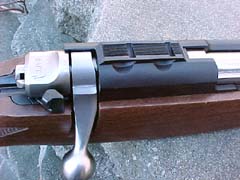
Ruger's Model 77/17 bolt rifle chambered for the .17 HMR
exhibits features usually found on centerfire rifles, such as
the excellent three-position safety, stainless bolt, steel
receiver, integral scope mounting system with rings supplied,
and attractive walnut stock with hand-cut checkering. Ruger
obviously envisions this gun as a serious tool for serious
hunters and shooters!
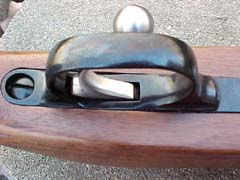
While many companies use plastic or aluminum for such
parts as trigger guards on their rimfire (and even centerfire)
offerings, the Ruger 77/17 is equipped with a polished steel
unit, adding to the ruggedness and beauty of the rifle.


In the spirit of their centerfire rifles, the Ruger
77/17 utilizes a controlled-feed system with dual extractors,
maintaining control of the cartridge at all times and guiding
the feeding cycle. This results in much greater reliability,
and there were no feeding, extraction, or ejection
irregularities of any kind during our testing.
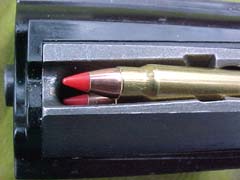
Ruger has adapted their famous rotary magazine design
for the Model 77/17, resulting in a nine-shot magazine that
offers perfect function and supreme reliability without
protruding below the action. This allows for proper balance
and carry, and does not detract from the gun's appearance.
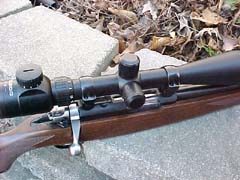

For accuracy testing, author mounted the excellent Tasco
6-24x variable Varmint/Tactical illuminated reticle scope.
This scope is a supremely well-made unit that maximizes the
practical capability of a well-made rifle such as the Ruger
77/17.
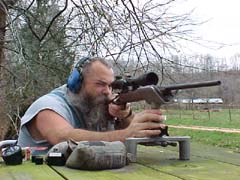
Author bench-testing the Ruger 77/17. Jeff was very
favorably impressed both by the gun and the .17 Hornady Magnum
Rimfire cartridge.
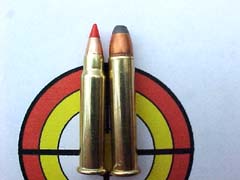
The .17 Hornady Magnum Rimfire (left) along with its
parent cartridge, the .22 Magnum (right). While comparisons
between the two excellent cartridges are inevitable, the .17
HMR was designed to fill a performance niche not met by any
rimfire cartridge.
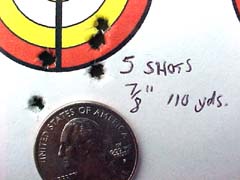
The combination of the .17 HMR in Ruger's 77/17 proved
to be a very accurate package, with 7/8" 5-shot groups at
110 yards being the norm. The .17 HMR is a fine performer with
great accuracy potential, flat trajectory, and excellent wind
deflection characteristics.

Author tested the .17 HMR in cans of lard. While not a
scientific gauge of real-world terminal performance, lard cans
are a consistent medium for comparison, having a hard outer
shell (the can) with a consistently-soft center. Fired at a
distance of 100 yards, the bullet left a 1/2-inch
"entrance wound" in the can and the first 3/4-inch
of lard.

"Exit wound" in lard can shows the explosive
performance of the .17 HMR. After initial penetration, the
"wound channel" opened to over four
inches, splitting the can lengthwise and cratering the lard for
a distance of six inches. Such explosive performance would be
devastating to predators and varmints at reasonable distances!
|
![]()